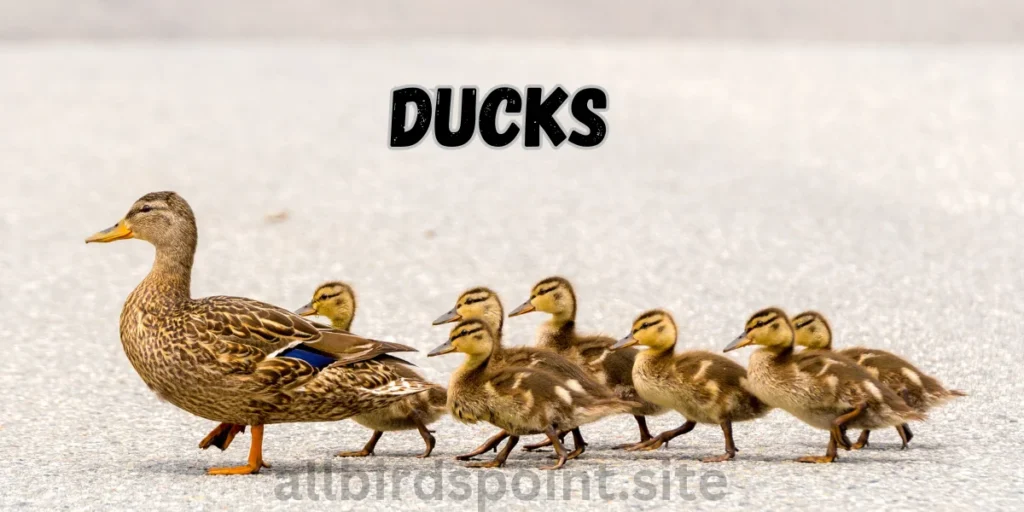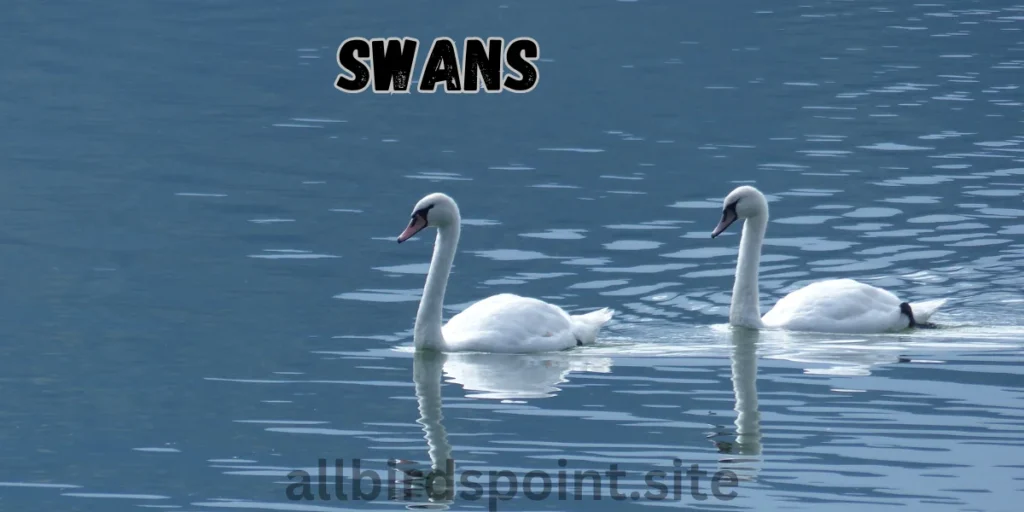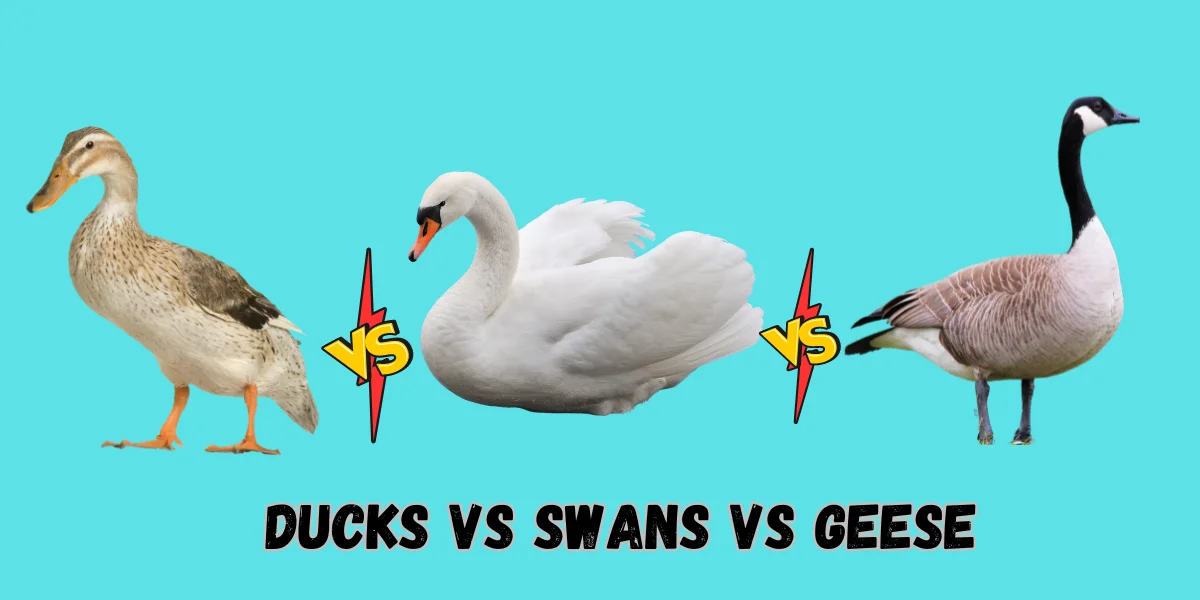When you spot birds around lakes, ponds, or rivers, you might notice ducks, swans, and geese. Although they may look similar, each type of bird has unique features and behaviors. Understanding these differences can help you identify them more easily and appreciate their distinct characteristics. In this guide, we’ll explore the key differences between ducks, swans, and geese, making it easier to tell them apart and learn more about these fascinating birds.
Difference Between Ducks vs Swans vs Geese?
| Feature | Ducks | Swans | Geese |
|---|---|---|---|
| Size | Smaller, compact | Larger, with long necks | Medium to large, stout bodies |
| Neck Length | Shorter necks | Long, elegant necks | Medium length necks |
| Beak Shape | Broad, flat | Long, slender | Broad, slightly rounded |
| Legs | Short legs | Long legs | Medium-length legs |
| Voice | Quack, various calls | Trumpet-like calls | Honking, various calls |
| Feeding | Dabbling or diving | Mostly dabbling, some diving | Grazing, dabbling |
| Habitat | Lakes, ponds, rivers | Lakes, large rivers, marshes | Lakes, rivers, grassy areas |
| Social Behavior | Often in small groups | Often in pairs or small groups | Usually in larger groups |
| Appearance | Various colors, patterns | Typically white, some black or gray | Generally brown, gray, or black |
| Flight | Fast and agile | Strong fliers, graceful | Steady fliers, often in V formation |
| Tail Shape | Fan-shaped or squared | Fan-shaped, often held high | Usually held straight or slightly fanned |
| Foot Webbing | Fully webbed feet | Fully webbed feet | Fully webbed feet |
| Breeding Season | Often in spring and summer | Usually spring and summer | Typically spring and summer |
| Nest Location | Nests on ground or in reeds | Nests on the ground or on platforms | Nests on the ground or in grass |
| Migration | Some migrate, some stay year-round | Most migrate, especially in North America and Europe | Most migrate, but some stay in temperate regions |
| Behavior in Winter | Some migrate to warmer areas | Migrate to warmer areas, some stay in temperate regions | Many migrate, some stay in milder climates |
Differences Between Ducks, Swans, and Geese
Understanding the distinctions between ducks, swans, and geese can enhance your birdwatching experience and appreciation for these diverse waterfowl. Although they may share some similarities, each type of bird has unique features and behaviors that set them apart. This guide provides a detailed look at what makes each bird unique.
Ducks

Physical Characteristics
- Size: Ducks are generally smaller and more compact than swans and geese. They range in size from 15 to 30 inches (38 to 76 cm) in length. Ducks’ smaller size helps them be agile and maneuverable in various environments.
- Neck Length: Ducks have shorter necks, which are proportionate to their compact bodies. This feature is adapted for their dabbling and diving feeding habits.
- Beak Shape: Ducks possess broad, flat beaks designed for filtering food from the water. The shape and size of the beak vary among species, adapting to their specific feeding techniques.
- Legs: Ducks have short legs placed towards the back of their bodies. This positioning aids in their swimming and diving abilities.
Behavior and Social Structure
- Voice: Ducks produce a wide range of vocalizations, including the familiar “quack” for many species. Their calls are used for communication among mates and within flocks.
- Feeding Habits: Ducks are versatile feeders. Dabbling ducks feed on the surface of the water or tip their bodies to reach underwater vegetation, while diving ducks submerge to catch fish and other aquatic organisms.
- Social Behavior: Ducks can be solitary or form small groups, depending on the species. Many are migratory and gather in larger flocks during migration periods.
Habitat and Distribution
- Habitat: Ducks thrive in a variety of environments, including freshwater lakes, ponds, rivers, and coastal areas. Their adaptability allows them to live in both natural and urban settings.
- Distribution: Ducks are found worldwide, with many species migrating between breeding and wintering grounds. They are present on every continent except Antarctica.
Reproduction
- Nest Location: Ducks build nests on the ground, often in tall grass or reeds near water. Some species may use abandoned nests of other birds.
- Eggs and Incubation: Duck eggs are laid in clutches of 8 to 12 eggs. The female incubates the eggs for about 28 to 30 days. Ducklings are precocial, meaning they are born with their eyes open and can walk and swim shortly after hatching.
| Feature | Ducks |
|---|---|
| Size | 15 to 30 inches (38 to 76 cm) |
| Neck Length | Short |
| Beak Shape | Broad, flat |
| Legs | Short, positioned towards back |
| Voice | Quack, various calls |
| Feeding | Dabbling or diving |
| Habitat | Lakes, ponds, rivers, coastal areas |
| Distribution | Worldwide, except Antarctica |
| Reproduction | Nests on ground, 8-12 eggs, incubated by female |
| Migration | Many species migrate, some stay year-round |
Swans

Physical Characteristics
- Size: Swans are the largest of the three, with long necks and large bodies. They can measure from 48 to 60 inches (122 to 152 cm) in length, with some species being even larger.
- Neck Length: Swans are known for their long, graceful necks. This adaptation allows them to reach down into the water and access aquatic vegetation while swimming.
- Beak Shape: Swans have long, slender beaks adapted for grazing on aquatic plants and foraging. The beak’s shape allows them to efficiently access food underwater.
- Legs: Swans have long legs that support their swimming and walking abilities. Their legs are often hidden under their bodies when swimming, making them less noticeable.
Behavior and Social Structure
- Voice: Swans are famous for their trumpet-like calls, which are used for communication, especially during courtship and territorial displays. Their calls are often melodic and can be heard from a distance.
- Feeding Habits: Swans are primarily dabblers, feeding on aquatic plants, insects, and small fish. They use their long necks to reach vegetation below the water’s surface.
- Social Behavior: Swans often form strong pair bonds and can be seen in pairs or small family groups. They are known for their monogamous relationships, often staying with the same mate for life.
Habitat and Distribution
- Habitat: Swans prefer large bodies of freshwater such as lakes, rivers, and marshes. They are less commonly found in saltwater environments and tend to avoid heavily urbanized areas.
- Distribution: Swans are found in North America, Europe, Asia, and parts of Africa. Some species migrate seasonally, while others are resident in temperate regions.
Reproduction
- Nest Location: Swans build large nests on the ground, often in shallow water or on small islands. Nests are constructed from reeds, grass, and other plant materials.
- Eggs and Incubation: Swans lay 4 to 8 eggs in a clutch. The female incubates the eggs for about 35 to 40 days, while the male guards the nest. Swan cygnets are precocial and can walk and swim soon after hatching.
| Feature | Swans |
|---|---|
| Size | 48 to 60 inches (122 to 152 cm) |
| Neck Length | Long, elegant |
| Beak Shape | Long, slender |
| Legs | Long, often hidden while swimming |
| Voice | Trumpet-like calls |
| Feeding | Primarily dabbling |
| Habitat | Large freshwater bodies like lakes, rivers |
| Distribution | North America, Europe, Asia, Africa |
| Reproduction | Nests on ground or small islands, 4-8 eggs, incubated by female |
| Migration | Many migrate seasonally, some are resident |
Geese

Physical Characteristics
- Size: Geese are medium to large birds, smaller than swans but larger than ducks. They generally range from 24 to 42 inches (61 to 107 cm) in length.
- Neck Length: Geese have medium-length necks, which are shorter than those of swans but longer than those of ducks. Their necks are adapted for grazing and feeding on land.
- Beak Shape: Geese have broad, slightly rounded beaks that are effective for grazing on grass and other vegetation. Their beaks are suited for their primarily herbivorous diet.
- Legs: Geese have medium-length legs that support their ability to walk on land and swim in water. Their legs are well-adapted for grazing and moving on grassy areas.
Behavior and Social Structure
- Voice: Geese are known for their distinctive honking calls, which they use for communication within their flocks, especially during migration. Their calls are loud and can carry over long distances.
- Feeding Habits: Geese are primarily grazers, feeding on grass, leaves, and seeds. They also dabble in water to access aquatic plants but prefer to graze on land.
- Social Behavior: Geese are highly social birds that often form large flocks. They have strong family bonds and are known for their organized migratory patterns, often traveling in V-shaped formations.
Habitat and Distribution
- Habitat: Geese are found in a variety of habitats, including lakes, rivers, marshes, and grassy fields. They are adaptable and can thrive in both natural and man-made environments.
- Distribution: Geese are distributed across North America, Europe, Asia, and parts of Africa. Many species are migratory, traveling between breeding and wintering grounds.
Reproduction
- Nest Location: Geese build their nests on the ground, often in grassy areas or on elevated sites such as riverbanks. Their nests are made from grass, feathers, and other plant materials.
- Eggs and Incubation: Geese lay 4 to 8 eggs in a clutch. The female incubates the eggs for about 25 to 30 days, while the male provides protection. Goslings are precocial and can walk and swim shortly after hatching.
| Feature | Geese |
|---|---|
| Size | 24 to 42 inches (61 to 107 cm) |
| Neck Length | Medium |
| Beak Shape | Broad, slightly rounded |
| Legs | Medium-length, suited for walking and swimming |
| Voice | Honking calls |
| Feeding | Grazing on grass, also dabbling |
| Habitat | Lakes, rivers, grassy fields |
| Distribution | North America, Europe, Asia, Africa |
| Reproduction | Nests on ground, 4-8 eggs, incubated by female |
| Migration | Many migrate, some stay in milder climates |
Conclusion
Ducks, swans, and geese each have unique characteristics that set them apart from one another. Ducks are smaller, versatile feeders with a wide range of vocalizations. Swans are the largest of the three, known for their long necks and graceful swimming. Geese are medium to large birds with strong social structures and distinctive honking calls. Understanding these differences enhances your ability to identify and appreciate these remarkable waterfowl in their natural habitats.
Here’s a short FAQ section on ducks, swans, and geese:
FAQs
1. What is the main difference between ducks, swans, and geese?
- Ducks: Smaller, short necks, broad beaks. Versatile feeders.
- Swans: Larger, long necks, slender beaks. Graceful swimmers.
- Geese: Medium-sized, medium necks, broad beaks. Grazers.
2. Can they interbreed?
- Ducks: Possible among closely related species.
- Swans: Some interbreeding occurs in overlapping ranges.
- Geese: Hybrids can occur, especially where species overlap.
3. How do they care for their young?
- Ducks: Female incubates, ducklings are precocial.
- Swans: Female incubates, cygnets are precocial.
- Geese: Female incubates, goslings are precocial.
4. Do they migrate?
- Ducks: Many migrate, some stay year-round.
- Swans: Many migrate seasonally; some are resident.
- Geese: Most migrate; some stay in milder climates.
5. What do they eat?
- Ducks: Aquatic plants, insects, small fish.
- Swans: Aquatic plants, insects, small fish.
- Geese: Grass, leaves, seeds.
6. How can I identify them?
- Ducks: Small, compact, short neck, broad beak.
- Swans: Large, long neck, graceful.
- Geese: Medium size, medium neck, broad beak.
7. Are they protected?
- Ducks: Yes, by various laws and regulations.
- Swans: Yes, by conservation laws and traditions.
- Geese: Yes, by hunting regulations and conservation efforts.
8. What are common threats?
- Ducks: Habitat loss, pollution, hunting.
- Swans: Habitat loss, pollution, disturbance.
- Geese: Habitat loss, hunting, disturbances.
